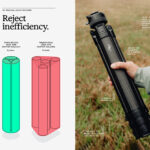Almost any photographer would agree that it’s easy to see the difference between a hard light and a soft light. However, one thing that many beginners struggle to grasp is that there is a large spectrum that lies between the two extremes. As photographer Mark Wallace demonstrates in the following tutorial, even the slightest repositioning of a light source can completely alter the way a scene or subject appears:
Although this lesson focuses entirely on soft lighting scenarios, it serves as an excellent example of just how drastically a simple light can play a role in making (or breaking) a photograph. Two strategies are discussed in depth over the course of Wallace’s lecture.
Diffused Light
Using a Profoto B2 250 AirTTL To-Go Kit, Wallace sets up his gear in a way that some might find perplexing. Rather than aiming toward the model, he instead faces his rigged flash toward a nearby wall. This causes the light to bounce off of the wall as well as the floor and ceiling. The result is a delicate, even light that wraps around the model. Her features are softened and her face is rounded, since the lack of shadows diminish the appearance of her facial contours. Because diffused light is scattered across the room, the background is well exposed and visible as well as the foreground.
Directional Light
Believe it or not, these two images feature the same model making an identical expression. By simply adding a Profoto 2′ Octagonal Off-Camera Flash Softbox to his setup and having the model step directly in front of the light, Wallace completely flips the mood and style of his image.
Because the softbox increases the overall size of the light source, the model is still hit with a soft, flattering light. However, the directional light falls on her much more so than the background, causing her to pop from her surroundings. Although she is still evenly lit, simply stepping in front of the soft box intensifies the shadows that accentuate her figure and bone structure.
The next time you find yourself with your finger on the shutter, take a moment to consider if a simple move forward, backward, or to the side might affect your shot for the better.
“When we look at a person’s face or a still life…the thing that makes it look three dimensional are the shadows. The more we have shadows shaping something, we can feel that two dimensional photo become three dimensional—or, we can take that away.”
Like This Article?
Don't Miss The Next One!
Join over 100,000 photographers of all experience levels who receive our free photography tips and articles to stay current:








Leave a Reply